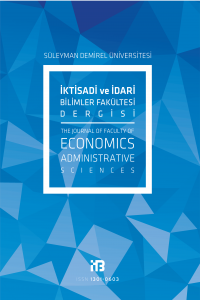MADDİ YOKSUNLUĞU ETKİLEYEN DEĞİŞKENLERİN LOJİSTİK REGRESYON ANALİZİ İLE BELİRLENMESİ
Yoksunluk, Maddi Yoksunluk, Lojistik Regresyon
DETERMINATION OF VARIABLES AFFECTING MATERIAL DEPRIVATION BY USING LOGISTIC REGRESSION ANALYSIS
Deprivation, Material Deprivation, Logistic Regression,
___
- AGRESTİ, A. (1996). An İntroduction To Categorical Data Analysis (Vol. 1350), New York: Wiley.
- ALPAR, R. (2013). Çok Değişkenli İstatistiksel Yöntemler (4. Baskı), Detay Yayıncılık, Ankara.
- ATASÜ, S.İ. (2017). An Investigation Of The Change In The Severe Material Deprivation Rate Of Turkey, Yüksek Lisans Tezi, Boğaziçi Universitesi, İstanbul.
- BAYRAM, N. (2004). “Multinominal Lojistik Regresyon Analizinin İstihdamdaki İşgücüne Uygulanması”, İktisat Fakültesi Mecmuası, 54(2): 61-75.
- BAYRAM, N. (2017). Sosyal Bilimlerde SPSS İle Veri Analizi, Ezgi Kitabevi, Bursa.
- BAYRAM, N., NESLİHAN, S. A. M., AYTAÇ, S., ve AYTAÇ, M. (2010). “Yaşam Tatmini ve Sosyal Dışlanma”, "İş, Güç" Endüstri İlişkileri Ve İnsan Kaynakları Dergisi, 12(04): 79-92.
- BOARİNİ, R. ve D'ERCOLE, M. M. (2006). “Measures of Material Deprivation in OECD Countries”, OECD Social, Employment and Migration Working Papers, No. 37, OECD Publishing, Paris.
- BOSSERT, W., CHAKRAVARTY, S. R. ve D'AMBROSİO, C. (2013). “Multidimensional Poverty and Material Deprivation With Discrete Data” Review of Income and Wealth, 59(1): 29-43.
- CRETTAZ, E. (2015). “Poverty and Material Deprivation Among European Workers in Times of Crisis” International Journal of Social Welfare, 24(4), 312-323.
- DE GRAAF-ZİJL, M., ve NOLAN, B. (2011). “Household Joblessness And İts İmpact On Poverty And Deprivation İn Europe”, Journal of European Social Policy, 21(5): 413-431.
- GUİO, A. C. (2005). “Material Deprivation In The EU” Statistics in Focus, 21, 2005.
- GÜRSEL, S., UYSAL, G. ve KÖKKIZIL, M. (2014). Üç Çocuktan İkisi Şiddetli Maddi Yoksunluk Çekiyor. Araştırma Notu.
- HOGAN, J. W. ve TCHERNİS, R. (2004). “Bayesian Factor Analysis For Spatially Correlated Data, With Application To Summarizing Area-Level Material Deprivation From Census Data”, Journal of the American Statistical Association, 99(466): 314-324.
- HOSMER, D. W. ve LEMESHOW, S. (2000). Applied Logistic Regression., 2nd edn.(Wiley: New York.). NY, USA.
- JULKUNEN, I. (2002). “Social And Material Deprivation Among Unemployed Youth İn Northern Europe”, Social Policy & Administration, 36(3): 235-253.
- MACK, J. ve LANSLEY, S. (1985). “Poor Britain” London: Georges Allen and Unwin.
- NELSON, K. (2012). “Counteracting material deprivation: The role of social assistance in Europe”, Journal of European Social Policy, 22(2): 148-163.
- NOLAN, B. ve WHELAN, C. T. (2010). “Using Non‐Monetary Deprivation Indicators to Analyze Poverty and Social Exclusion: Lessons From Europe?” Journal of Policy Analysis and Management, 29(2): 305-325.
- TOWNSEND, P. (1979). Poverty İn The United Kingdom: A Survey Of Household Resources And Standards Of Living, Univ of California Press.
- TOWNSEND, P. (1987). “Deprivation. Journal of Social Policy”, 16(2): 125-146.
- TÜİK (2016). “Gelir ve Yaşam Koşulları Araştırması”,www.tuik.gov.tr/PdfGetir.do?id=24579, 26.06.2018.
- WHELAN, C. T., NOLAN, B. ve MAİTRE, B. (2008). “Measuring Material Deprivation in The Enlarged EU” Economic and Social Research Institute, ESRI Working Paper; No.
- ISSN: 1301-0603
- Yayın Aralığı: Yılda 3 Sayı
- Başlangıç: 1996
- Yayıncı: Süleyman Demirel Üniversitesi
YARGISAL YÜKSEK DENETİM MODELİNDE FRANSA SAYIŞTAYININ ANALİZİ
GEÇİCİ KORUMA STATÜSÜ İLE TÜRKİYE’DE BULUNAN SURİYELİLERİN VATANDAŞLIK HAKKI
İŞYERİNDE ALGILANAN DEDİKODUNUN PSİKOLOJİK RAHATLIK VE SORUMLULUK ÜSTLENME DAVRANIŞI ÜZERİNE ETKİSİ
PERSONEL DEĞERLEME SİSTEMİ İÇİN KARAR DESTEK SİSTEMİ TASARIMI
ELİTLERİN GÖSTERİŞÇİ TÜKETİMİ VE ELIAS’IN SARAY TOPLUMU
MADDİ YOKSUNLUĞU ETKİLEYEN DEĞİŞKENLERİN LOJİSTİK REGRESYON ANALİZİ İLE BELİRLENMESİ
ÇALIŞANLARIN YEŞİL DAVRANIŞININ KAVRAMSAL ÇERÇEVEDE İNCELENMESİ
